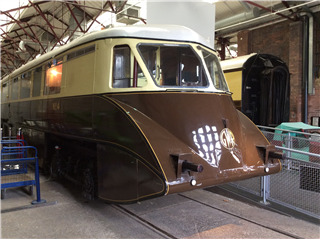In 1933, the Great Western Railway introduced the first of what was to become a very successful series of diesel railcars, which survived in regular use into the 1960s, when they were replaced with the new British Rail "first generation" type diesel multiple units.
The original design featured streamlined bodywork, which was very much the fashion at the time. The rounded lines of the first examples built led to their nickname: "flying banana". The preserved W4W is an example of the original, rounded body shape. Later "razor edge" examples, such as No. 27, had much more angular bodywork, yet the nickname persisted for these too.
Railcars No. 1 to No. 18 were powered by a high-speed diesel engine manufactured by A.E.C, producing a maximum brake power output of 130 hp (97 kW). The engine was of the straight 6 configuration, with a bore of 115 mm diameter and a stroke of 142 mm. This gave a total displacement of 8.85 litres. The maximum operating speed was 1,800 rpm. Railcars No. 19 onwards were powered by a modified version of the previous engine. This engine was equipped with direct injection and the bore diameter was enlarged to 120 mm. The stroke remaining at 142 mm. This engine produced a lower brake power output of 105 hp at 1,650 rpm.
Three of the GWR railcars have survived into preservation
